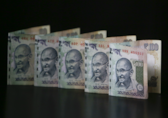File image of an N95 mask
India has managed to flip the supply situation on face masks, going from suffering a shortage of the product to now having surplus stock of surgical and N95 masks.
The oversupply is such that at least 50 percent of companies engaged in the business will likely down shutters – some already have plans to do so, as per a Times of India report.
Experts told the paper that “unethical market practices, poor domestic demand and red-tapism” has reduced capacity utilisation to just one-third.
Moneycontrol could not independently verify the report.
Follow our LIVE Updates on the coronavirus pandemic here
“Production capacity for N95 masks is 20 crore units per month, while the utilisation is merely 10 percent. Similarly for surgical masks, capacity is more than 60 crore units/month of which only 30 percent is used,” Anshumali Jain, president of the All India Mask Manufacturers Association told the paper.
Experts added that high demand and low availability of masks at the beginning of the pandemic led new entrants into the segment, while existing players expanded production in April-June, on hopes that demand would continue to be high.
“Established players were able to use their full capacity for a brief time, but once exports were banned, demand started dropping drastically, and supply kept getting created just as fast, resulting in extreme oversupply,” Jain added.
Not only inventories, but underutilised plants and machinery are also a concern.
Check here for the latest updates on all COVID-19 vaccines
The ban on export of masks was imposed in March to ensure adequate domestic supply of masks amid increasing cases. This was lifted for 3-ply masks in August, but India missed the boat to become the export hub by then and the industry had become more competitive.
The ban on export of N95 masks was only lifted in October – which was also too late, noted Rajiv Nath, forum coordinator of industry body AiMeD. “Many manufacturers are now struggling to sell finished goods, or even raw materials' inventory, below costs to create cash flow. It's survival of the fittest, and those who can export surplus capacity,” he added.
Other factors were the government’s encouragement of ‘gamcha’ (thin towels) as a substitute for masks, cheap Chinese options flooding the market in June and government advisory on valved respirators which hit demand for N95 masks, the report said.
Follow our full COVID-19 coverage here











_2020091018165303jzv.jpg)
























